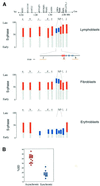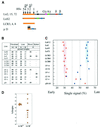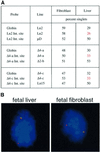Developmental regulation of DNA replication timing at the human beta globin locus
- PMID: 11689454
- PMCID: PMC125288
- DOI: 10.1093/emboj/20.21.6150
Developmental regulation of DNA replication timing at the human beta globin locus
Abstract
The human beta globin locus replicates late in most cell types, but becomes early replicating in erythroid cells. Using FISH to map DNA replication timing around the endogenous beta globin locus and by applying a genetic approach in transgenic mice, we have demonstrated that both the late and early replication states are controlled by regulatory elements within the locus control region. These results also show that the pattern of replication timing is set up by mechanisms that work independently of gene transcription.
Figures




Similar articles
-
Analysis of the developmental and transcriptional potentiation functions of 5'HS2 of the murine beta-globin locus control region in transgenic mice.Dev Biol. 1994 Oct;165(2):574-84. doi: 10.1006/dbio.1994.1277. Dev Biol. 1994. PMID: 7958423
-
Cluster specific regulation pattern of upstream regulatory elements in human alpha- and beta-globin gene clusters.Exp Cell Res. 2008 Jan 1;314(1):115-22. doi: 10.1016/j.yexcr.2007.08.014. Epub 2007 Aug 24. Exp Cell Res. 2008. PMID: 17996867
-
Proper developmental control of human globin genes reproduced by transgenic mice containing a 160-kb BAC carrying the human beta-globin locus.Blood Cells Mol Dis. 2000 Dec;26(6):598-610. doi: 10.1006/bcmd.2000.0339. Blood Cells Mol Dis. 2000. PMID: 11358351
-
Progress toward the genetic treatment of the beta-thalassemias.Ann N Y Acad Sci. 2005;1054:78-91. doi: 10.1196/annals.1345.010. Ann N Y Acad Sci. 2005. PMID: 16339654 Review.
-
Role of intergenic human gamma-delta-globin sequences in human hemoglobin switching and reactivation of fetal hemoglobin in adult erythroid cells.Ann N Y Acad Sci. 2005;1054:48-54. doi: 10.1196/annals.1345.057. Ann N Y Acad Sci. 2005. PMID: 16339651 Review.
Cited by
-
A replicator-specific binding protein essential for site-specific initiation of DNA replication in mammalian cells.Nat Commun. 2016 Jun 8;7:11748. doi: 10.1038/ncomms11748. Nat Commun. 2016. PMID: 27272143 Free PMC article.
-
Alterations in replication timing of cancer-related genes in malignant human breast cancer cells.J Cell Biochem. 2013 May;114(5):1074-83. doi: 10.1002/jcb.24447. J Cell Biochem. 2013. PMID: 23161755 Free PMC article.
-
A multiprotein complex necessary for both transcription and DNA replication at the β-globin locus.EMBO J. 2010 Oct 6;29(19):3260-71. doi: 10.1038/emboj.2010.204. Epub 2010 Aug 31. EMBO J. 2010. PMID: 20808282 Free PMC article.
-
Control of DNA replication timing in the 3D genome.Nat Rev Mol Cell Biol. 2019 Dec;20(12):721-737. doi: 10.1038/s41580-019-0162-y. Epub 2019 Sep 2. Nat Rev Mol Cell Biol. 2019. PMID: 31477886 Free PMC article. Review.
-
Domain-wide regulation of DNA replication timing during mammalian development.Chromosome Res. 2010 Jan;18(1):127-36. doi: 10.1007/s10577-009-9100-8. Chromosome Res. 2010. PMID: 20013151 Free PMC article.
References
-
- Aladjem M.I., Groudine,M., Brody,L.L., Dieken,E.S., Fournier,R.E.K., Wahl,G.M. and Epner,E.M. (1995) Participation of human β-globin locus control region in initation of DNA replication. Science, 270, 815–819. - PubMed
-
- Aladjem M.I., Rodewald,L.W., Kolman,J.L. and Wahl,G.M. (1998) Genetic dissection of a mammalian replicator in the human β-globin locus. Science, 281, 1005–1009. - PubMed
-
- Allshire R. and Bickmore,W. (2000) Pausing for thought on the boundaries of imprinting. Cell, 102, 705–708. - PubMed
-
- Berry M., Grosveld,F. and Dillon,N. (1992) A single point mutation is the cause of the Greek form of hereditary persistence of fetal haemoglobin. Nature, 358, 499–502. - PubMed
-
- Bulger M., von Doorninck,J.H., Saitoh,N., Telling,A., Farrell,C., Bender,M.A., Felsenfeld,G., Axel,R. and Groudine,M. (1999) Conservation of sequence and structure flanking the mouse and human β-globin loci: The β-globin genes are embedded within an array of odorant receptor genes. Proc. Natl Acad. Sci. USA, 96, 5129–5134. - PMC - PubMed
Publication types
MeSH terms
Substances
LinkOut - more resources
Full Text Sources

